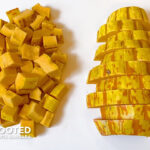 The first holiday of the chilly months may be behind us but Winter Squash Season is in full swing and there are still plenty of weeks left to indulge. According to the Santa Barbara Farmers Market, you can expect to find locally grown winter squash “in-season” from August through December! Here we’ll demystify a few varieties of winter squash and share some recipes from our friends at Default Veg.
The first holiday of the chilly months may be behind us but Winter Squash Season is in full swing and there are still plenty of weeks left to indulge. According to the Santa Barbara Farmers Market, you can expect to find locally grown winter squash “in-season” from August through December! Here we’ll demystify a few varieties of winter squash and share some recipes from our friends at Default Veg.
Squash is super versatile, lasts longer than other veggies if stored properly, and there are many different types. Some squash or gourds may seem a little intimidating, either due to their size (too big OR too small) or their tough skin, but they’re a great source of nourishment and nutrients and historically significant as one of the oldest known crops on earth. Some can be peeled and chopped relatively easily, some can be partially cooked (par-cooked), boiled, steamed or microwaved briefly prior to chopping whilst others are best left to the oven first by piercing the skin and chopping only once fully cooked.
Most winter squash varieties are rich in the following nutrients according to the Harvard School of Public Health:
Potassium
Magnesium
Vitamin A
Vitamin C
Vitamin B-6
Let’s get started with a little info and how to handle the most well-known of the winter squash varieties.
The Famous Butternut Squash
When I think of squash, I first think of butternut squash, it’s a fan favorite in our house and pretty easy to find in most grocery stores – some are even pre-prepped and ready to cook. Butternut squash will last for a few weeks if stored in a cool place.
Butternut squash can look a little intimidating but it’s actually very easy to prepare and cook, and is truly enjoyed by most. Chop the ends, peel the skin, scoop out the seeds, and chop. Here’s a quick video to guide you if you haven’t done this before.
If you choose to cube or slice, you can then roast it in the oven at 375* for about 50 minutes or until they turn golden brown.
Or, if you’re using the meat as a purée, you can pierce the squash all over and pressure cook it whole just follow your cooker’s instructions to keep it off the bottom of the pot. Add a cup of water to the cooker and cook for 10-25 minutes (depending on size) and scoop it out when cool enough to handle.
But don’t get squished into using just one type of squash – eating a diversity of foods is nature’s medicine and there are over two dozen squash varieties, many of them available now. Here are a few of our favorites as well as some lesser-known to check out plus a great collection of recipes to play around with.
Five Other Types of Winter Squash
Delicata Squash
A big selling feature is that you don’t need to peel a delicata. The skin is thin enough to be enjoyed once cooked, but that also means it doesn’t store for as long as other varieties. Chop it up, scoop out the seeds then roast, bake, or sauté it.
Acorn Squash
A smaller, more manageable squash with a mild, buttery flavor and conveniently comes in its own bowl – simply cut it in half and bake it filled with all sorts of goodies. Try a quinoa and cranberry “stuffing” inside! You can cut these and roast them in pieces, but you’ll want to peel them as the skin is tough.
Spaghetti Squash
This football-sized squash which once cooked, a fork run across the meat will result in strands of spaghetti-like deliciousness. While lots of folks treat it like spaghetti and put marinara sauce on it, the acidity does tend to break down the strands, so dressing it with something more garlicky is ideal if you’re into that.
Kabocha Squash
Kabocha is also known as “Japanese Pumpkin” and is another favorite of ours – the skin is edible and the meat is delicious, a nice mixture between a pumpkin and a sweet potato. If you haven’t had them yet, you really ought to try the BBQ Kabocha Squash Ribs (yes, ribs!) at Uncorked on East Haley. Popping this beauty into a microwave for 3-4 minutes makes it a whole lot easier to cut!
Festival/Carnival Squash
These green, white, and orange speckled squashes are a hybrid of acorn squash and sweet dumpling squash and their flavor is a little nutty, a little sweet, and a little buttery. You can cook these in the oven or in a slow cooker – just half or quarter and enjoy. Yum!
Winter Squash Recipes
If you’re ready to get more winter squash into your kitchen, you’ll love the recipes our friends over at Default Veg helped us pull together. These delicious winter squash recipes will absolutely help you get your squash on!
Default Veg is an amazing organization with a simple mission to help institutions, organizations, restaurants, schools, and homes: Make plant-based food the default and give people the choice to opt-in for meals with animal products. Default Veg is inclusive, reduces your carbon footprint, and increases the healthfulness of your meals.
What a great concept, and one we at Rooted are actively encouraging our local restaurants to adopt. Defaulting to plants helps lower food costs and enables more concise Profit & Loss reporting, plus a menu that is truly accessible to all – such a win-win!
Do you have a favorite winter squash and a tried and true way of preparing it? If so, we’d love to hear about it. Tag us on Instagram or Facebook with your favorite squash-inspired meals!
Emma Malina is a plant-based nutrition educator and food-skills instructor based in Santa Barbara, CA who empowers individuals and families worldwide to optimize their health and prevent chronic disease through nutrition education, cooking classes, coaching, and online resources through her business Basking in Goodness.
The first holiday of the chilly months may be behind us but Winter Squash Season is in full swing and there are still plenty of weeks left to indulge. According to the Santa Barbara Farmers Market, you can expect to find locally grown winter squash “in-season” from August through December! Here we’ll demystify a few varieties of winter squash and share some recipes from our friends at Default Veg.
Squash is super versatile, lasts longer than other veggies if stored properly, and there are many different types. Some squash or gourds may seem a little intimidating, either due to their size (too big OR too small) or their tough skin, but they’re a great source of nourishment and nutrients and historically significant as one of the oldest known crops on earth. Some can be peeled and chopped relatively easily, some can be partially cooked (par-cooked), boiled, steamed or microwaved briefly prior to chopping whilst others are best left to the oven first by piercing the skin and chopping only once fully cooked.
Most winter squash varieties are rich in the following nutrients according to the Harvard School of Public Health:
- Potassium
- Magnesium
- Vitamin A
- Vitamin C
- Vitamin B-6
Let’s get started with a little info and how to handle the most well-known of the winter squash varieties.
The Famous Butternut Squash
When I think of squash, I first think of butternut squash, it’s a fan favorite in our house and pretty easy to find in most grocery stores – some are even pre-prepped and ready to cook. Butternut squash will last for a few weeks if stored in a cool place.
Butternut squash can look a little intimidating but it’s actually very easy to prepare and cook, and is truly enjoyed by most. Chop the ends, peel the skin, scoop out the seeds, and chop. Here’s a quick video to guide you if you haven’t done this before.
If you choose to cube or slice, you can then roast it in the oven at 375* for about 50 minutes or until they turn golden brown.
Or, if you’re using the meat as a purée, you can pierce the squash all over and pressure cook it whole just follow your cooker’s instructions to keep it off the bottom of the pot. Add a cup of water to the cooker and cook for 10-25 minutes (depending on size) and scoop it out when cool enough to handle.
But don’t get squished into using just one type of squash – eating a diversity of foods is nature’s medicine and there are over two dozen squash varieties, many of them available now. Here are a few of our favorites as well as some lesser-known to check out plus a great collection of recipes to play around with.
Five Other Types of Winter Squash
Delicata Squash
A big selling feature is that you don’t need to peel a delicata. The skin is thin enough to be enjoyed once cooked, but that also means it doesn’t store for as long as other varieties. Chop it up, scoop out the seeds then roast, bake, or sauté it.
Acorn Squash
A smaller, more manageable squash with a mild, buttery flavor and conveniently comes in its own bowl – simply cut it in half and bake it filled with all sorts of goodies. Try a quinoa and cranberry “stuffing” inside! You can cut these and roast them in pieces, but you’ll want to peel them as the skin is tough.
Spaghetti Squash
This football-sized squash which once cooked, a fork run across the meat will result in strands of spaghetti-like deliciousness. While lots of folks treat it like spaghetti and put marinara sauce on it, the acidity does tend to break down the strands, so dressing it with something more garlicky is ideal if you’re into that.
Kabocha Squash
Kabocha is also known as “Japanese Pumpkin” and is another favorite of ours – the skin is edible and the meat is delicious, a nice mixture between a pumpkin and a sweet potato. If you haven’t had them yet, you really ought to try the BBQ Kabocha Squash Ribs (yes, ribs!) at Uncorked on East Haley. Popping this beauty into a microwave for 3-4 minutes makes it a whole lot easier to cut!
Festival/Carnival Squash
These green, white, and orange speckled squashes are a hybrid of acorn squash and sweet dumpling squash and their flavor is a little nutty, a little sweet, and a little buttery. You can cook these in the oven or in a slow cooker – just half or quarter and enjoy. Yum!
Winter Squash Recipes
If you’re ready to get more winter squash into your kitchen, you’ll love the recipes our friends over at Default Veg helped us pull together. These delicious winter squash recipes will absolutely help you get your squash on!
Default Veg is an amazing organization with a simple mission to help institutions, organizations, restaurants, schools, and homes: Make plant-based food the default and give people the choice to opt-in for meals with animal products. Default Veg is inclusive, reduces your carbon footprint, and increases the healthfulness of your meals.
What a great concept, and one we at Rooted are actively encouraging our local restaurants to adopt. Defaulting to plants helps lower food costs and enables more concise Profit & Loss reporting, plus a menu that is truly accessible to all – such a win-win!
Do you have a favorite winter squash and a tried and true way of preparing it? If so, we’d love to hear about it. Tag us on Instagram or Facebook with your favorite squash-inspired meals!
Emma Malina is a plant-based nutrition educator and food-skills instructor based in Santa Barbara, CA who empowers individuals and families worldwide to optimize their health and prevent chronic disease through nutrition education, cooking classes, coaching, and online resources through her business Basking in Goodness.
Discovering the Abundance of Plant-Based Living
By Lizzy FallowsWhen our oldest daughter turned one, I said no to cow’s milk. It was tricky; my husband, our...
Super Fudgy Flourless Brownies
Super Fudgy Flourless Brownies Whole food... plant-based... brownies? Yes, please! Santa Barbara native Nathalie...
Research Highlight: Dr. Erin Presant on Lifestyle Medicine’s Impact on Brain Health
Empowerment. That’s the word that comes to mind when I think of Lifestyle Medicine. As a neurologist that works...
Supporting Our Work - We’re currently an all-volunteer organization and we see incredible room and need to grow over the coming year. We understand that this time has enormous challenges for everyone, so while we’ll be seeking support to help roll our vision forward, we’re also thinking creatively to keep our costs low to efficiently build resources and deliver programming at low to no cost to our community. If you’d like to support our work, we hope you’ll consider making a donation to one of our giving programs through our community partner, the Santa Barbara Foundation!



